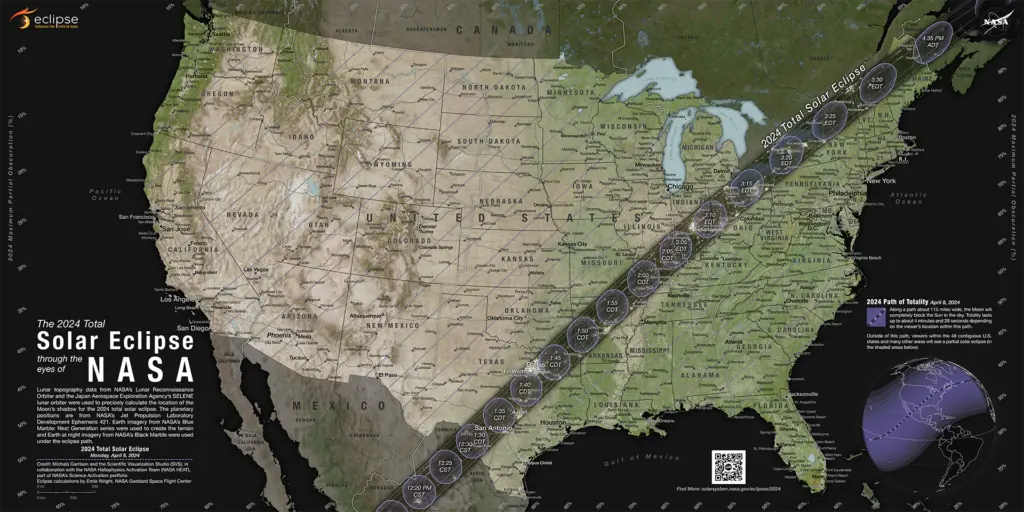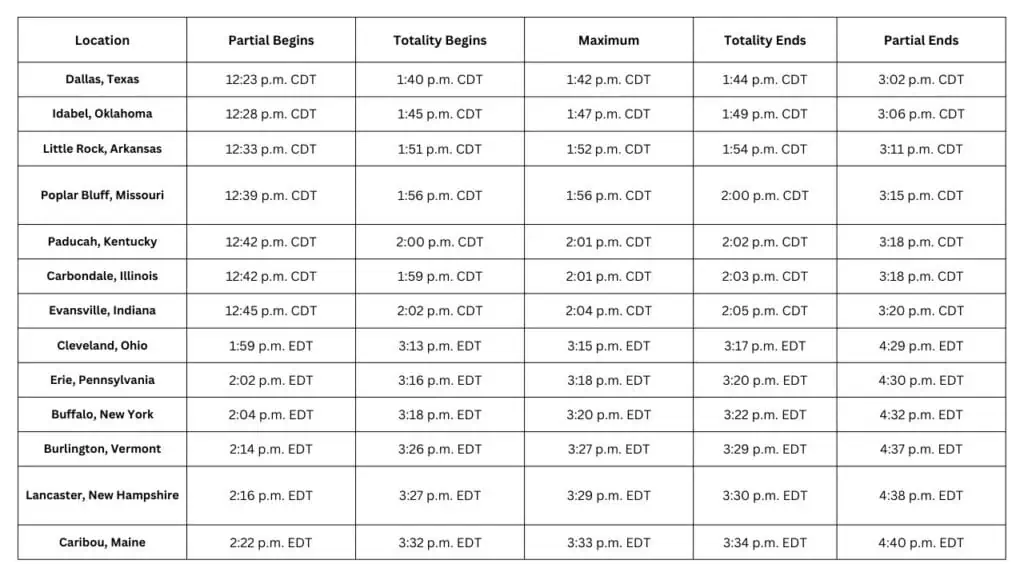On Monday, April 8, 2024, a total solar eclipse will cross Mexico, the United States, and Canada. As the moon gracefully aligns itself between the Earth and the sun, it will cast a shadow across a significant portion of North America, turning day into an eerie twilight and revealing the mesmerizing solar corona.
Total solar eclipses are relatively rare events occurring on Earth roughly every 18 months but are not usually visible from the same location.
[This article contains affiliate links to trusted partners.]
Where Will the Total Solar Eclipse Be Visible?
According to NASA, the eclipse’s trajectory proceeds from Mexico and enters the United States through Texas, crossing over Oklahoma, Arkansas, Missouri, Illinois, Kentucky, Indiana, Ohio, Pennsylvania, New York, Vermont, New Hampshire, and Maine. Additionally, partial eclipse experiences will be in select areas of Tennessee and Michigan.

What Time Will the Total Solar Eclipse Occur in My Location?
The following table provided by NASA presents the starting time of totality in select U.S. cities along the eclipse path. These regions will also witness a partial eclipse before and after these specified times.
The duration of totality, where the moon completely blocks the sun, will vary along the eclipse path. It can range from a few seconds to over four minutes in some locations.

How to Safely View the Total Solar Eclipse
Use Proper Eye Protection: The most important rule is never to look directly at the sun during any eclipse phase without proper eye protection. Regular sunglasses or homemade filters are not safe. You must use specialized eclipse glasses or viewers with certified solar filters that meet the ISO 12312-2 safety standard. Make sure they have no visible damage or scratches.
Use Solar Filters for Cameras and Binoculars: If you plan to take photographs or use binoculars or telescopes to view the eclipse, ensure they have certified solar filters. These filters are designed to protect both your eyes and your equipment.
Pinhole Projection: An indirect and safe way to view the eclipse is by creating a pinhole projector. You can make one by poking a small hole in a piece of cardboard and allowing the sunlight to project an image of the eclipse onto another surface, like a piece of paper or the ground. Never look through the pinhole at the sun.
Live Streams and Broadcasting: If you cannot obtain proper eye protection or are in an area where the eclipse is not visible, consider watching the live broadcast on NASA’s YouTube Channel.
Phases of a Total Solar Eclipse
A total solar eclipse occurs when the moon passes directly between the Earth and the sun, completely blocking the sun’s disk for a brief period. This alignment results in the moon casting a shadow on the Earth’s surface, creating temporary darkness during the day.
During a total solar eclipse, several distinct phases can be observed:
Partial Eclipse: At the beginning of the eclipse, the moon starts to move in front of the sun, partially obscuring its disk. Depending on your location, this partial eclipse phase can last an hour or more.
Totality: The most dramatic phase of a total solar eclipse is totality. It occurs when the moon entirely covers the sun, revealing the sun’s outer atmosphere, known as the solar corona. This phase typically lasts only a few minutes, during which the sky darkens, stars become visible, and the sun’s corona appears as a glowing halo around the moon.
Diamond Ring Effect: Just before and after totality, there is a brief moment known as the “diamond ring effect.” As the moon covers the last bit of the sun’s surface, only a small portion of the sun remains visible, resembling a shining diamond ring.
Partial Eclipse Resumes: Following totality, the moon gradually moves away from the sun, and the partial eclipse phase resumes until the moon no longer blocks any part of the sun’s disk.
When is the Next Solar Eclipse?
- On October 2, 2024, an annular solar eclipse will be visible in South America and a partial eclipse in South America, Antarctica, the Pacific Ocean, the Atlantic Ocean, and North America.
- March 29, 2025, will bring a partial solar eclipse that can be seen in Europe, Asia, Africa, North America, South America, and the Atlantic and Arctic Oceans.
- Mark your calendars for September 21, 2025, when a partial solar eclipse will be observable in Australia, Antarctica, the Pacific, and the Atlantic.
April 8, 2024 Total Solar Eclipse
Don’t miss this extraordinary opportunity to witness the 2024 total solar eclipse! Be sure to plan ahead, follow safety guidelines, and join millions in savoring the wonder of a celestial spectacle.
Featured Photo Credit: [@I_g0rZh/DepositPhotos]
ABOUT THE AUTHOR
Alexandrea Sumuel is a nationally syndicated travel writer and founder of the Wander With Alex travel blog. Her work has appeared on MSN, YAHOO!, Euronews, and FOX, ABC, and NBC affiliates across the United States.
Alex travels to experience, eat, explore, and occasionally escape! She collaborates with destinations, vacation property management companies, and hospitality technology firms to provide her readers with exclusive insights and information.